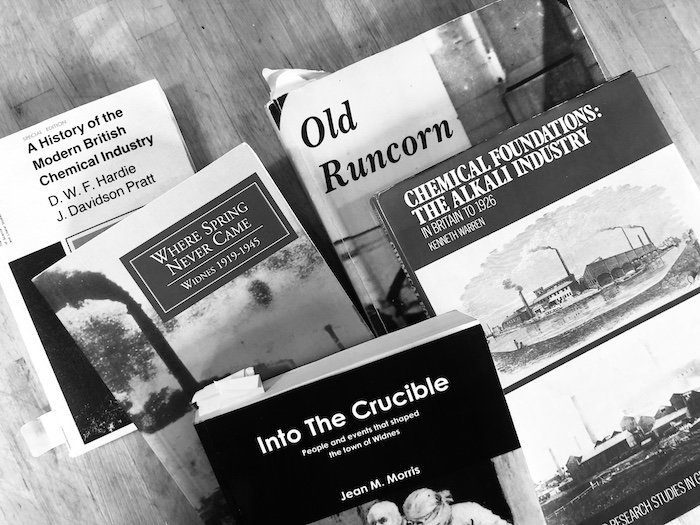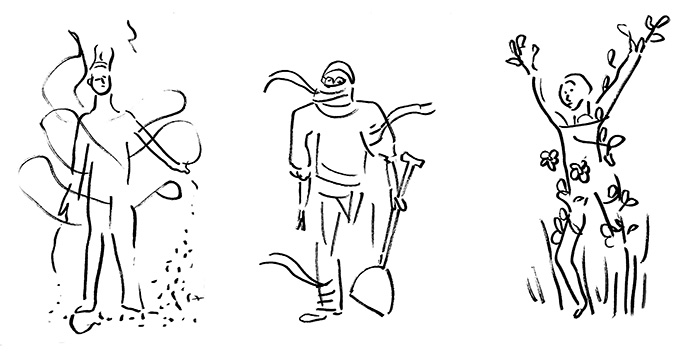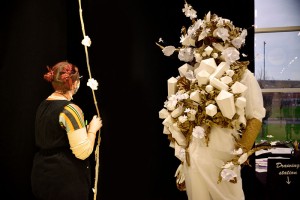Below are some of the themes/ ideas that might be included in the poem/ soundtrack for The Bleach Packers video projections. They express the dualities of Halton. The overall story will be of a Bleach Packer, in a chemical dream that will torn him between progress/science/discovery/economic growth and nature/wildlife/peace.
Lou Chapelle has been appointed by Halton Borough Council to create an ambitious artwork inspired by Halton chemical industry, and working with young people from the borough. Following a series of workshops in October/November 2021, the work will consist of large scale public projections, reinventing the stories of the Halton Bleach Packers and other trades of the chemical industry. It will be created with collaborating artists: costume designer Rachael Prime, sound artist Wendy Smith, poet Louise Fazackerley and film-maker Tim Brunsden. Young people from Halton are invited to contribute to the piece, and we are currently working with Fashion students, Graphic Design students, Dance students and Music students at Cronton Sixth Form College, the Young Choir group and GLOW group at The Studio.
More information about Halton’s heritage can be found at Catalyst and on the Halton Heritage Partnership website
Information below was collated from diverse websites including Wikipedia, and books: Jean M.Morris ‘Into the Crucible’ (our favourite!) and ‘Where Spring Never Came’, D.W.F. Hardie and J. Davidson Pratt ‘A History of the Modern British Chemical Industry, H.F. Starkey ‘Old Runcorn’, and Kenneth Warren ‘Chemical Foundations: The Alkali Industry’
Black and white
Black and White
> (The costumes created for the video will be black and white)
> One of the main use of bleach was to whiten fabric. Before that people used to bleach fabric by laying it on the ground, and the sun would do that same process but it would take months rather hours.
> It is also used to whiten paper, flour
> Your table salt is bleached!
> Do we want a clean white world?
> What does black represent?
> Leblanc process was one of the main chemical processes used in the factories, to produce soda ash (used in soap, glass, paper, cleaning products, etc). A bi-product (waste) of this process was Hydrochloric Acid, which was then turned into Chlorine (a yellow-green poisonous gas). The Lime dressers would put lime powder on the floor of large rooms, then the chlorine gas would pour in and seep in the lime. This created Bleaching powder, that the Bleach Packers would then scoop with spades and put into cylindrical containers.
The black dragon/ or black swan (smoke coming out of the factories look like the smoke coming out of a dragon’s mouth) versus the white swan (lots os families of swans along the estuary)
> The families of swans in Halton are the specie: “Mute swans”
> The Swans are a popular family attraction.
> The smoke and the mist that drifted around the black stalagmites of the chimneys of industrial Widnes.
> Jaws of hell.
> Where spring never came.
> These factories set out fetid odours, gases and perilous dust that invaded both the lungs and homes of these who lived in such close proximity.
> There are few people who have not heard of stinking Widnes and its melancholy surroundings, where trees and edges, and grass alike have the look of being scorched up as if by fire.”
> More on wildlife (Pickerings Pasture website) here.
> More on Halton industrial landscape here.
The murmur of starlings over sunset versus the noise of the factories and the clouds of smoke.
> gazes, smells and flocks of birds, how they use the air to shift-shape.
The sea water versus the liquid chemicals
> Water flows up and down with the unstoppable tide. Constant movement.
The breathy fresh sea air vs the gas chemical
> Tall chimneys drew the fire and helped to dissipate the acid fumes into the upper atmosphere.
> The polluted heavy atmosphere serves to emphasise the evil.
> Being in nature lowers cortisol, reduces heart rate, bolsters immunity, improves mood. The outdoors is a powerful healing space.
> More on beautiful places here.
Bleach packer, a victim (dangerous working conditions, exploited) or a winner (they were the highest paid members of the factory workers)
> Chlorine produces suffocation, cough, and laboured breathing.
> The powder-packing chamber is enclosed, and there is a very slight draught. Sometimes men will have to go in with muzzles and run out a few moments, or run out in half an hour, some of them drop down. If they inhale through their nostrils at all, it has a very bad effect, they become gassed, and sometimes have to lie up for two or three days. Then they receive no pay.
> The sensation they complain of is in the throat – a choking sensation, as if they were asphyxiated. They must inhale through all these rolls of flannel and exhale through the nostrils. But in addition to this muzzle through which they must breathe, they must wear goggles over their eyes; and then, and portion of the skin that is exposed, they put tallow or grease on, and most of these men cannot eat any food until they take a stimulant, whiskey or rum.
> In some factories, the men averaged 84 hours a week. 56 hours one week and 112 in another, or 186 a fortnight.
>The elite of the works were the bleaching powder men, the bleach packers and lime dressers. The lime dressers dressed the lime on the floor or on shelves, an operation which was not dangerous but merely unpleasant; his hands and arms were smeared with grease, his trouser-legs wrapped with sheets of brown paper, and theoretically his face protected by mask and goggles. The Bleach packer raked out the chlorinated lime into casks. He was similarly protected, for he had the additional hazard of chlorine gaz to content with.
> More on Bleach Packers and working conditions here.
Bleach packer, a polluter/killer (bleach kills / the bleach packer with his scary snake eyes and alien outfit) or a hero (bleach keeps us germ free and saves lives/ the bleach packer with his cape)
> Cleaning and disinfecting your home are effective ways to prevent the spread of illnesses and disease.
> Many chemicals applied in the natural domain function as negative catalysts, obscuring or poisoning normal processes of the organisms.”
> How does bleach bleach? It is the gold standard of sanitation, and a single drop is often all it takes to render a litre of water bacteria-free and safe to drink.
> There can’t be too many reminders that bleach is, gasp, a poison. In fact, in the United States, household bleach is the number one cause of accidental poisonings.
Fabric and paper
> The work is so detrimental to clothing that many of the men wear suits of paper – some of them having new ones everyday.
> As protection against the hazards of the powder, bleach packers wore improvised muzzles of 20 to 30 layers of flannel and rapped their limbs in cloth or brown paper. Even so they were often overcome by the fumes from the powder. After working hours the bleach packers retreated to their favourite public house, where, note to give offence to other customers in their bizarre working clothes, they drank apart in the ‘packers’huts’.
The bridges
> Metaphor of the links between the black and the white? How Halton holds the opposite concepts (described above) together.
Chemical reactions
In 1792, the French chemist Nicolas Leblanc patented a process for producing sodium carbonate (also known as soda ash) from salt, sulfuric acid, limestone, and coal. In the first step, sodium chloride is treated with sulfuric acid in the Mannheim process. This reaction produces sodium sulfate (salt cake) and hydrogen chloride (this is the waste product that is used for Bleach Powder)
2NaCl + H2SO4 → Na2SO4 + 2HCl
The salt cake and crushed limestone (calcium carbonate) was reduced by heating with coal.[17] This conversion entails two parts. First is the carbothermic reaction whereby the coal, a source of carbon, reduces the sulfate to sulfide:
Na2SO4 + 2C → Na2S + 2CO2
The second stage is the reaction to produce sodium carbonate and calcium sulfide:
Na2S + CaCO3 → Na2CO3 + CaS
This mixture is called black ash. The soda ash is extracted from the black ash with water. Evaporation of this extract yields solid sodium carbonate. This extraction process was termed lixiviating.
Sulphuric acid (needed to make the soda ash but also for making TNT during the 2nd world war) and Fool’s Gold
> Most of the ingredients could be found locally (e.g. salt from Cheshire, Limestone from Quarrys in St helens). The only thing that had to be imported was Pyrites (also called Fool’s Gold). Suphur could be extracted from this beautiful golden stone. It came com Spain and Ireland.
> More on Fool’s Gold here.
Local and immigrant workers.
> The majority of the ‘non-local’ workers came from Ireland (huge influx during the potato famine), and some came from Lithuania and Poland.
> Interesting to see that pyrites also came from Ireland, and that during the potato famine, a lot of the potatoes produced in Ireland were shipped out to mainland England.






